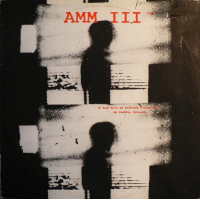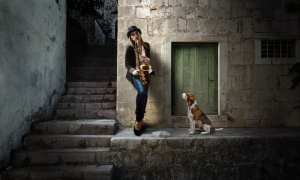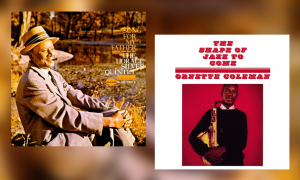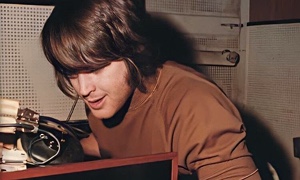Home » Jazz Articles » Building a Jazz Library » AMM at 50
AMM at 50
Back in 1965, Prévost was initially joined by guitarist Keith Rowe and saxophonist Lou Gare who had both previously been members of Mike Westbrook's band, Gare and Prévost having played together in a hard bop quintet. By 1966, the group had expanded to a quintet with the addition of avant-garde composer Cornelius Cardew on piano and cello, plus former Westbrook band bassist Lawrence Sheaff who played accordion and cello in AMM, not bass. In his definitive thousand-page biography of Cardew, Cornelius Cardew (1936-1981) a life unfinished (Copula, 2008), John Tilbury noted, "Keith Rowe was without doubt the magnet which, initially, drew Cardew to AMM—a formidable and uncompromising personality which Cardew found hard to fathom."
Around the time of those arrivals, the group also acquired the name AMM, having been nameless prior to that. The members of AMM have always been coy about the full band name, while seeming to delight in any curiosity about it. The lack of any concrete information has led to much speculation, with band members stoically refraining from comment on names such as Adventures in Modern Music, Anonymous Music Makers or countless others. Although it was denied on the Matchless website, it seems most likely that AMM stands for Audacis Musicae Magistri (Latin for Audacious Music Masters.) Evidence in support of this was to be found at the 2015 Huddersfield Contemporary Music Festival at which AMM appeared; an accompanying exhibition of AMM artefacts from the sixties and seventies contained some fascinating documents. One of these was the mock-up label for a "Chateau AMM" wine which bore in smaller print the words Audacis Musicae Magistri. Nearby, a publicity flyer for a seventies concert announced "Music Now presents Audacis Musicae Magistri: Lou Gare (tenor saxophone), Eddie Prévost (percussion)..." But if you find such evidence less convincing than earlier denials, you may prefer to opt for Rowe's own invention, Ain't Much Money! Either way, the group seems likely to always be known just as AMM...
Formed around the same time as Spontaneous Music Ensemble, and occasionally invited by SME to play at the Little Theatre Club, AMM took a very different path to SME. The inclusion of classically trained musicians such as Cardew, cellist Rohan de Saram and pianist John Tilbury meant there were fewer traces of AMM music having evolved from free jazz, particularly as any semblance of rhythm was dropped early in the group's existence. AMM music was always spontaneous, with nothing ever planned. As Cardew wrote of AMM, "We are searching for sounds and for responses that attach to them, rather than thinking them up, preparing them and producing them. The search is conducted in the medium of sound and the musician is at the heart of the experiment."
Since 1965, there have been several distinct phases of AMM. The list below represents all of these plus key recordings the group has made with guest musicians, with no two albums on the list having exactly the same line-up.
 AMMMusic 1966 (Elektra, 1967 / ReR Megacorp, 1989)
AMMMusic 1966 (Elektra, 1967 / ReR Megacorp, 1989) The earliest released AMM track is the six-and-a-half-minute "Live at the Royal College of Art," recorded in March 1966, which is on the compilation Not Necessarily "English Music" (EMF, 2001) curated by David Toop. Unreleased recordings of "proto-AMM" from late 1965 also exist in which the group still exhibits links to jazz.
AMMMusic was the group's first album. The world was a very different place back in the mid-sixties. Although not a rock band, AMM opened for Cream at The Roundhouse and played on the same bill as Pink Floyd at the UFO club, where Rowe's guitar playing was much admired by Syd Barrett. AMM were also considered chic enough to be profiled in the pages of Vogue magazine. So it is not too surprising that this album was originally released on Elektra (at the time the home of Tim Buckley, The Doors and Love.) The rear of the album sleeve bore an unattributed maxim that gives insight into AMM music, "The reason for playing is to find out why I want to play."
Setting a trend for future AMM releases, the album featured distinctive artwork by Rowe. Although it could be picked up cheaply from bargain bins in the sixties, original copies of the LP still change hands for about £400 / $600—but save your money because the CD re-release contains music that was not on the vinyl. Starting another AMM trend, Cardew, Rowe and Sheaff were all credited with electronics (transistor radio), which explains the occasional surreal interjections such as announcements in a cut- glass upper class BBC accent! At other times, the music can sound distantly related to post-Barrett Pink Floyd but, as the album title was intended to convey, AMM music was like nothing else, a law unto itself. An auspicious debut...
 The Crypt 12th June 1968 (Matchless, 1981)
The Crypt 12th June 1968 (Matchless, 1981) By 1968, Sheaff had left AMM (reportedly, he ceased making music) and been replaced by one of Cardew's students, Christopher Hobbs, on percussion. In the years since the Elektra album, the music had evolved and matured. Compared to the debut album, AMM sounds less like a group of individuals and more integrated. This may reflect the fact that the Elektra album was studio-recorded while this one was live in front of an audience.
When I asked Keith Rowe in November 2015 which was his favourite AMM album, he singled this out, commenting that it was like a fine wine that had matured and was now ready for drinking. (Incidentally, when asked the same question, Tilbury chose the Elektra debut, citing Cardew's piano as a reason.) Many fans' favourite, The Crypt 12th June 1968 is one of the more essential AMM albums.
 AMM at the Roundhouse (Incus EP, 1972 / Anomalous, 2004)
AMM at the Roundhouse (Incus EP, 1972 / Anomalous, 2004) The sixties had seen AMM mature and evolve, but the seventies brought an end to that process, if not a reverse. In the context of their entire output, the group's seventies album are very listenable but feel like interesting cul-de-sacs, not seeming to be part of the group's steady development. Early in the decade, AMM separated along ideological lines into two predictable factions, Rowe & Cardew and Prévost & Gare. By 1972, Rowe and Cardew had departed, leaving Prévost and Gare as the AMM line-up that recorded this album live at the International Carnival of Experimental Sound at The Roundhouse in August 1972. Some of this music had the peculiar distinction of being the only 7" disc ever issued by Incus. This CD issue includes the AMM performance in its entirety. Given the pair's jazz background together, this is the nearest AMM ever came to a straight jazz album, with Prévost playing a conventional kit conventionally and Gare soloing fluently for much of the time, with occasional silences as punctuation.
 It Had Been An Ordinary Enough Day In Pueblo, Colorado (Japo, 1979)
It Had Been An Ordinary Enough Day In Pueblo, Colorado (Japo, 1979) By 1976, after attempts to reconvene the quartet, Gare and Cardew both departed, again leaving a duo—Prévost and Rowe. [Gare would briefly rejoin in 1989-90, appearing on The Nameless Uncarved Block (Matchless, 1990)] In recognition of the fact that AMM was evolving through various incarnations, It Had Been An Ordinary Enough Day In Pueblo, Colorado was credited to AMM III (AMM I being the quintet, and AMM II the Prévost-Gare duo.)
On this album, Rowe's use of radio is much in evidence—the album title is a verbatim quote from a US radio drama heard on the disc. Most people who saw AMM live, during this period and after, can recall occasions when Rowe's radio emitted an inappropriate or surreal contribution. Rowe also plays far more guitar here than at any other time in AMM, exploiting the space available to him with sustained notes and staccato runs. Prevost provides sympathetic support throughout, sounding less jazzy than with Gare, mixing his trademark resonating bowed cymbals with use of snare.
In 1981, Cornelius Cardew was killed in a late-night, hit-and-run accident near his home, the circumstances raising suspicions that he had been deliberately killed because of his radical political views. Cardew had been vitally important in the early years of AMM, and over the years the group acknowledged that by recording more than one version of his ambitious graphic score Treatise and by marking significant anniversaries of his death.
 Laminal (Matchless, 1996)
Laminal (Matchless, 1996) In 1981, after Cardew's death, pianist John Tilbury (who had occasionally played with AMM in the sixties when Cardew was not available) joined the group, so completing the best-known and longest-lasting AMM line-up of Prévost, Rowe and Tilbury (not called AMM IV, you will notice).
Released to coincide with the group's thirtieth anniversary, Laminal should be considered as the first choice from this list. (Its only serious competitor would be The Crypt.) Laminal makes an excellent introduction to AMM or a (very) potted history, consisting of three discs with contrasting recordings from three distinct periods spanning a quarter of a century—Prévost, Rowe, Gare, Cardew and Hobbs in Denmark in 1969, the first recordings from the Prévost-Rowe-Tilbury trio in The Great Hall at Goldsmith's College, London (see YouTube below), in 1982, and the same trio in New York in 1994. (After some deliberation, Prévost chose The Great Hall disc as his own favourite AMM recording, because of the sound they achieved in the space.)
The booklet that accompanies the discs contains some priceless reminiscences, from Prévost, Tilbury and, one-time AMM manager, Victor Schoenfield who recalls separate visits to watch AMM play by Ornette Coleman and Paul McCartney. The former was asked by Gare to leave for talking, and the latter commented that AMM went on too long...
The album title echoes a comment from (occasional guest player with AMM from the sixties to the present) Evan Parker that AMM music is "laminar"—consisting of superimposed layers of sound—in contrast to the "atomistic" music of others such as SME. Rowe's cover art of a submarine sandwich visually represents such layers.
 The Inexhaustible Document (Matchless, 1987)
The Inexhaustible Document (Matchless, 1987) The Inexhaustible Document is the only recording from the period between 1986 and 1994 when cellist Rohan de Saram was a member of the group. Being very experienced with the classical repertoire, both solo and in the Arditti Quartet, but not as experienced an improviser as the other three, de Saram fitted in easily enough. As always—from Cornelius Cardew through to Ute Kanngiesser—the inclusion of cello in AMM feels natural and right. As is true of other guest appearances with AMM, de Saram's contribution supports the "laminar" view of AMM music; it seems a guest musician can easily slot in, adding another layer to those already there.
 Newfoundland (Matchless, 1993)
Newfoundland (Matchless, 1993) Captured live in the Canadian province of the title, Newfoundland is one of the best discs recorded by Prévost-Rowe-Tilbury (of which there are about ten altogether). Across the album's sole seventy-seven minute track, the three create a text book example of laminar playing, laying down a complex, multi- layered soundscape in which the layers are clearly distinguishable and fit together as essential parts of the whole.
In the nineties AMM were in consistently good form, so their trio albums from this period are all excellent. This choice could just as easily have been Live in Allentown USA (Matchless, 1996) or Before driving to the chapel, we took coffee with Rick and Jennifer Reed (Matchless, 1997) both recorded live in USA.
The late nineties saw significant changes outside of AMM for both Rowe and Prévost. Although he had recorded three previous albums outside of AMM (all released on Matchless), from 2000 onwards the flow of such Rowe albums increased dramatically, in particular those released on the nascent Erstwhile label; one such was the remarkable Duos for Doris (Erstwhile, 2003) a duo album with Tilbury. Imperceptibly Rowe had evolved from playing guitar plus electronics to electronics plus guitar to electronics without guitar. So when Rowe was interviewed for All About Jazz in 2009, he said, "Some years ago I decided to castrate the guitar, in fact; I cut the neck off which is a symbol of castration... Reducing it to almost nothing is probably an appropriate thing to do. But it is quite nice to have reference to it, a guitar-like thing. At the moment I am using a thing called a finger trainer which you might have seen. A finger trainer is a device for classical guitar players to practice their fingering. It is just six frets and no body."
Meanwhile, in 1999 when Prévost returned from a jazz festival and colloquium in Guelph, Canada, he decided to set up and develop an improvisation workshop. Meeting on Friday evening weekly ever since, this workshop has been open to players of any ability and any instrument to attend (but not to spectators). It has attracted from three to twenty-five players, the total number of participants being well into the hundreds. The workshop has usually been led by Prévost himself, who always stresses to participants the importance of taking risks and searching for sounds rather than presenting pre-prepared materials. The workshop has been a reliable supplier of innovative, exploratory players to the London improv community and beyond.
 Fine (Matchless, 2001)
Fine (Matchless, 2001) This album is credited to Prévost, Rowe and Tilbury plus dancer Fine Kwiatkowski. While Kwiatkowski cannot be heard on the recording, it is right and proper that she was credited as her presence undoubtedly played a part in shaping the music here, and also right that the album bears her name. For most of the album—doubtless to avoid distracting attention from the dancer—the music is quiet and subdued with the most noticeable sounds being occasional piano arpeggios from Tilbury while Prévost confines himself to textural scraping or rubbing and Rowe's drones are felt more than heard. Only towards the end do the energy levels and volume rise, leading to an impressive climax. A uniquely different AMM album, but very memorable and appealing.
 Apogee (Matchless, 2005)
Apogee (Matchless, 2005)Recorded during the (then) annual Freedom of the City festival at London's Conway Hall in May 2004, this album is notable for two contrasting reasons. Firstly, it contains studio recordings featuring AMM together with Musica Elettronica Viva (MEV), the trio of Alvin Curran, Fréderic Rzewski and Richard Teitelbaum, the two trios having first shared a record back in 1970 (the artwork of this CD echoes that 12" cover). Secondly, it contains the separate live sets played at the festival by MEV and AMM; the AMM set is notable as being the last appearance of AMM with Keith Rowe before he left due to friction between himself and Prévost over remarks the drummer made about the guitarist in his book Minute Particulars (Copula, 2004).
On that book's opening page, Prévost had written, "The constant discussions with my AMM colleagues (Keith Rowe and John Tilbury) have always proved to be both contentious and demanding. There is a no-holds-barred atmosphere in most of our debates which is certainly reflected in some of the material below. We often hold very strong, contrary and contradictory views."
 Sounding Music (Matchless, 2010)
Sounding Music (Matchless, 2010) In the aftermath of Rowe's departure, the duo of Prévost and Tilbury went through a phase of playing in trios with guests; these included Sachiko M, David Jackman and John Butcher, the latter being on the album Trinity, recorded in concert .
Sounding Music was recorded at the 2009 Freedom of the City festival (five years after Rowe's last AMM concert) when the group was expanded to a quintet with the addition of Butcher plus Christian Wolff (who had first played with AMM in 1968 during a sabbatical year in London, and also in 2001) and cellist Ute Kanngiesser, one of the stars from Prévost's weekly workshop. Except for the absence of guitar, that instrumental line-up came close to that of the original quintet, but the music it produced was not comparable, being far more measured and contemplative.
 Two London Concerts (Matchless, 2012)
Two London Concerts (Matchless, 2012) After the spate of trios with guests, Prévost and Tilbury settled into a routine of occasional AMM appearances as a duo, at home and abroad, with their album releases reflecting this. Two London Concerts showcases music from two significant occasions. From March 2011, the As Alike As Trees festival marked over ten years of Prévost's weekly workshop, while a concert later the same year at The Purcell Room celebrated Cornelius Cardew's life, works and legacy, thirty years after his untimely death in a hit-and-run traffic incident. Audience members at the March performance were astonished by the atypical ferocity of Tilbury's playing as he opened with a series of forearm smashed to the keyboard that unleashed resounding block chords. Prevost did not respond in kind but added restrained tones that eventually led to a varied set, showing the duo at their best.
Finally, in a development that even took seasoned AMM watchers unawares, in November and December 2015, to mark the fiftieth anniversary of the group they played two concerts —at the Huddersfield Contemporary Music Festival and at London's Café Oto—with the line-up of Prévost, Tilbury and Rowe, the first occasions in some eleven years that all three had appeared together. The reconciliation was described by both Prevost and Rowe as amicable. The music showed no signs of the break; it was as engaging as ever and will surely be released by Matchless in due course. (If and when that happens, it should be added to the list above.) At the end of the Huddersfield concert, the three musicians embraced as they received prolonged applause—if one were making a film of the AMM story, that would be the perfect closing freeze- frame.
It remains to be seen whether the reconciliation will be long lasting. Yes, even after all this time, the AMM saga continues to unfold...
Tags
PREVIOUS / NEXT
Support All About Jazz
 All About Jazz has been a pillar of jazz since 1995, championing it as an art form and, more importantly, supporting the musicians who make it. Our enduring commitment has made "AAJ" one of the most culturally important websites of its kind, read by hundreds of thousands of fans, musicians and industry figures every month.
All About Jazz has been a pillar of jazz since 1995, championing it as an art form and, more importantly, supporting the musicians who make it. Our enduring commitment has made "AAJ" one of the most culturally important websites of its kind, read by hundreds of thousands of fans, musicians and industry figures every month.





















